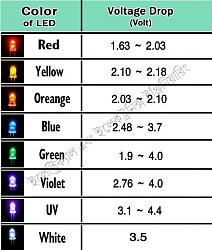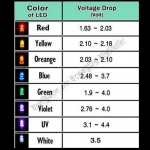LEDs are used often enough in home projects that it's worth a short tutorial on determining the proper resistor to be used with one.
The breakdown voltage of an LED (Vb) varies with color. This chart shows ranges of that voltage...
A typical supply current is I=20 ma. The required resistor can then be calculated from Ohm's law (R = V/I)
R = (Vs - Vb)/0.02
here Vs is the power supply voltage.
An example will help. Suppose we have a red LED we wish to power with a 12 volt battery. From the figure, the average Vb for a red LED is 1.9 volts.
Then:
R = (12-1.9) / 0.02 = 10.1 * 50 = 505 ohms
The standard series of resistors looks like..
1 1.2 1.5 1.8 2.2 2.7 3.3 3.9 4.7 5.6 6.8 8.2 10
All of these values can be multiplied by powers of ten (1.2 12 120 - 1200, etc.).
So the closest we can come to 505 is a 470 ohm resistor.
The resistor color code is
0 black
1 brown
2 red
3 orange
4 yellow
5 green
6 blue
7 violet
8 gray
9 white
The third color band indicates the power of ten multiplier.
so a 470 ohm resistor will have yellow-violet-brown bands.
Most LEDs will have a flat area on the base to indicate the cathode (negative) terminal. Sometimes, the cathode lead is made shorter to indicate which it is.


 LinkBack URL
LinkBack URL About LinkBacks
About LinkBacks



 Reply With Quote
Reply With Quote




Bookmarks